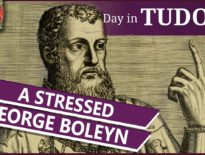On this day in Tudor history, 12th November 1555, Mary I’s Lord Chancellor, Stephen Gardiner, Bishop of Winchester, died. He was laid to rest at Winchester Cathedral in what is now known as the Bishop Gardiner Chantry Chapel.
In today's talk, I tell you about the life and career of "Wily Winchester", a man who went from being a valued advisor to being imprisoned, and then got back into favour, crowned a queen and became Lord Chancellor! He led quite a life!
Also on this day in Tudor history, 12th November 1537, the corpse of Queen Jane Seymour, Henry VIII's third wife, was transported by chariot in a procession from Hampton Court Palace to Windsor Castle, in preparation for burial. Jane Seymour's heart and entrails had been buried in the chapel at Hampton Court Palace following her death on 24th October 1537. Queen Jane's stepdaughter, the Lady Mary, acted as chief mourner for the proceedings. In last year’s video, I gave details of the procession, the service at St George's Chapel, Windsor Castle, where Jane was buried, and the commemoration in the city of London, so do watch it:
Also on this day in history:
- 1532 – Henry VIII and Anne Boleyn finally left Calais after being delayed by a Channel fog. They landed at Dover on Thursday 14th November. They had been visiting Calais to meet with the French king, Francis I.
- 1541 - Queen Catherine Howard was examined by members of the King’s Council following Francis Dereham’s claim that Thomas Culpeper had replaced him in the Queen’s affections after her marriage to Henry VIII.
- 1554 – The opening of Mary I’s third Parliament. At this Parliament, a bill was passed allowing the exiled Cardinal Reginald Pole to return to England as papal legate.
- 1555 – Mary I's Parliament re-established Catholicism in England.
- 1576 – Death of Sir Edward Saunders, judge. He was buried at Weston under Wetherley, Warwickshire. Saunders' offices included Serjeant-at-Law, Recorder of Coventry, Chief Justice of the King's Bench and Chief Baron of the Exchequer.
- 1586 – A delegation of forty MPs and twenty peers presented Elizabeth I with a petition demanding that “a just sentence might be followed by as just an execution” in the case of Mary, Queen of Scots.
- 1595 – Death of Sir John Hawkins, merchant, shipbuilder, navigator, explorer, slave trader and naval commander, at Puerto Rico on a voyage, with Sir Francis Drake, which aimed to capture Panama. He was buried at sea. Hawkins is known for being the chief architect of Elizabeth I's navy, and he was knighted for gallantry after serving as Vice-Admiral during the Spanish Armada.
Transcript:
On this day in Tudor history, 12th November 1555, Mary I’s Lord Chancellor, Stephen Gardiner, Bishop of Winchester, died. He was laid to rest at Winchester Cathedral in what is now known as the Bishop Gardiner Chantry Chapel.
Today’s talk is based on an excerpt from my book “On this Day in Tudor history” about Gardiner’s life and career...
Stephen Gardiner’s date of birth is not known, with some saying 1483 and others saying 1493 or 1497, but he was born in Bury St Edmunds in Suffolk. His father was William Gardiner (some say John Gardiner), a cloth merchant and a mercenary hired during the War of the Roses, and his mother is thought to have been called Agnes. According to some Welsh accounts of the 1485 Battle of Bosworth, it was “Wyllyam Gardynyr” who killed King Richard III with a poleaxe. Sir William Gardiner later married Helen Tudor, a woman said to have been the illegitimate daughter of Jasper Tudor, uncle of King Henry VII. Recent research, however, suggests Helen was the mother of monk Thomas Gardiner, though.
As a young man, Stephen Gardiner met the famous humanist scholar, Desiderius Erasmus, in Paris and he studied at Trinity Hall, Cambridge. He had received doctorates in both Civil Law and Canon law by 1522, and went on to work for Cardinal Thomas Wolsey, Henry VIII’s Lord Chancellor, as secretary in around 1524. He met Henry VIII for the first time in 1525 at The More in Hertfordshire for the signing of the Treaty of the More between the King and Francis I of France. Two years later, in 1527, Gardiner and Sir Thomas More worked as commissioners in arranging, with the French ambassadors, a treaty to obtain support for an army against the Holy Roman Emperor, Charles V, in Italy.
In 1527, Gardiner accompanied his master, Wolsey, on a diplomatic mission to France to gain the French King’s support for “the King’s Great Matter” (or “secret matter”), his wish to divorce Catherine of Aragon. A year later, Gardiner was sent to Italy with Edward Foxe, the provost of King’s College, Cambridge, to secure a decretal commission from the Pope which would allow Cardinal Wolsey to rule on the validity of the King’s marriage without appeal to Rome. Although Gardiner was an expert on canon law, and so was at a great advantage, Pope Clement VII had recently been imprisoned by Charles V’s troops, and was wary of offending the Emperor who was Catherine of Aragon’s nephew, and so refused to grant the decretal commission and instead granted a general commission to allow Cardinal Wolsey to try the case in England with the Papal Legate, Cardinal Campeggio.
In 1526, Gardiner was appointed Archdeacon of Taunton and then in 1529 Archdeacon of Norfolk, a post from which he resigned in 1531, when he became Archdeacon of Leicester. In the summer of 1529, Gardiner also moved from Wolsey’s service to that of King Henry VIII, serving him as his principal secretary and from then on was highly involved in the King’s Great Matter.
In November 1531, Gardiner was appointed as Bishop of Winchester after successfully procuring a decision from the University of Cambridge on the unlawfulness of a man marrying his dead brother’s wife. However, he offended the King a year later when he was involved in preparing the “Answer of the Ordinaries”, a reply to the “Supplication Against the Ordinaries” which had been drawn up by the House of Commons and presented to the southern convocation by Archbishop Warham. It was an attack attack on the legal powers and privileges of bishops and ecclesiastical officials. Gardiner answered by stating that the church’s right to make laws came from God and denied that these laws needed royal approval. The king was not impressed, and the imperial ambassador reported a division between secretary and king, suggesting that Gardiner was now a supporter of Catherine of Aragon and was refusing to preach in favour of the king.
In May 1533, following Henry VIII’s marriage to Anne Boleyn, Gardiner assisted the Archbishop of Canterbury, Thomas Cranmer, in pronouncing the marriage between Henry VIII and Catherine of Aragon null and void, and in 1535 he was one of the bishops asked to vindicate Henry VIII’s new title “Supreme Head of the Church of England”, something which he did by writing a treatise in which he argued that rulers were entitled to supremacy in their own country’s churches, and that the pope had no legitimate power over other churches.
Between 1535 and 1539, Gardiner was mostly abroad on diplomatic missions, but in 1539 he helped to prepare “The Six Articles”, which reaffirmed the traditional Catholic doctrine on transubstantiation, clerical celibacy, the vow of chastity, the withholding of the cup from the laity at communion, private masses and auricular confession. In 1543, Gardiner was involved in the Prebendaries’ Plot against Archbishop Cranmer, along with his nephew, Germain Gardiner. The plot failed when the King supported Cranmer. Gardiner survived, but his nephew, the scapegoat, was executed for treason. In 1546, Gardiner, along with Lord Chancellor Thomas Wriothesley, attempted to turn the King against his sixth wife, the Reformist Catherine Parr. The plot failed when Catherine managed to reconcile with the King.
On the 28th January 1547, King Henry VIII died, and although Gardiner had been one of his trusted advisers, he was not named as an executor in the King’s will. During the Protestant reign of Edward VI, Gardiner was imprisoned, first in the Fleet and then in the Tower of London, for his opposition to the religious changes being made. However, he was released at the accession of Mary I in 1553, restored to his bishopric, and made the Queen’s Lord Chancellor. He crowned Mary I Queen of England at her coronation at Westminster Abbey on the 1st October 1553, and helped Mary to restore Catholicism and, ironically, overturn the annulment of her parents’ marriage, making her legitimate. He was also instrumental in the marriage negotiations between Mary and Philip II of Spain, and married the couple at Winchester Cathedral on the 25th July 1554.
It is not clear what Gardiner’s role was in the Marian persecutions, but it appears that he preferred to try and persuade people to save themselves by recanting and reconciling themselves to the church. It has been pointed out that in his own diocese, nobody was persecuted until after Gardiner’s death.
In May 1555, Gardiner carried out his last diplomatic mission to France, to promote peace, a mission that was not successful, and in October 1555 he opened Parliament. On the 12th November 1555, after being taken ill at the end of October, the famous Tudor statesman and lawyer, Stephen Gardiner, Bishop of Winchester and Lord Chancellor of England, died. It is thought that he was in his sixties, and that he had been suffering from jaundice and dropsy, although there were rumours that he’d been poisoned. It is said that as he lay dying, the story of the Passion was read to him, and that his dying words in Latin, after hearing of the denial of Peter, translated to “Like Peter I have erred, unlike Peter I have not wept”, an allusion to his weakness during the reign of Henry VIII.
Gardiner’s entrails were buried in St Mary Overy, in Southwark, and his body buried in a chantry tomb in Winchester Cathedral.
Stephen Gardiner has gone down in history as “Wily Winchester”, a nickname given to him by martyrologist John Foxe, who, as a Protestant, viewed him as “a man hated of God and all good men”.
Trivia: Protestant Catherine Willoughby, Duchess of Suffolk, wife of Charles Brandon, named her little dog “Gardiner” and enjoyed calling him to heel!



Leave a Reply